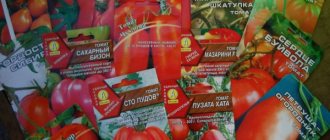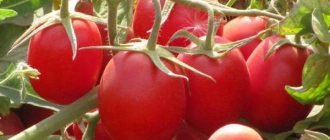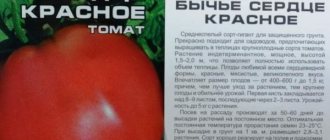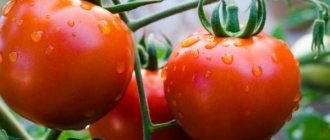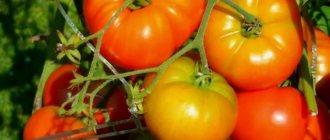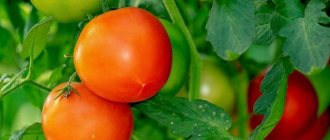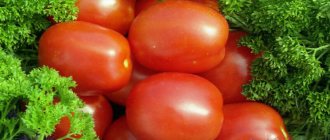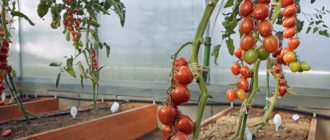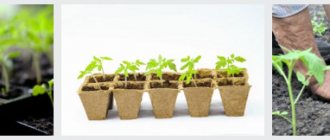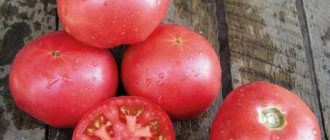There are a lot of varieties and hybrids of tomatoes, they all differ from each other in the shape, color and taste of the fruit, the number and size of seeds and seed chambers, the structure of the pulp, the timing of crop ripening, and resistance to diseases. They also differ significantly in the size and type of bush, its growth and the number of formed flower ovaries.
The weight of tomato fruits varies from 20 to 1000 g, and the height of the plants themselves ranges from 30 cm to 2.5 m, and sometimes more. Depending on the ability of the plant to grow upward and lay a crop, i.e., according to the type of development of the vegetative system, tomato varieties are distinguished into determinate and indeterminate.
Geography of the variety
Indeterminate varieties of tomatoes are varieties of medium and late ripening and have a long growing season. Their normal development requires long daylight hours. They can be quite successfully cultivated in heated buildings in all southern, central and even northern regions.
In unheated greenhouses, plants can be grown no further north than the central region, since early autumn frosts can stop growth, and low temperatures will contribute to the development of diseases.
In the central regions, it is possible to grow early varieties from indeterminate ones, since the late ones, even if they manage to set fruit, their ripening will remain in question. In open ground, the variety is suitable for cultivation in the southern regions.
Nuances
It is known that growing tomatoes requires special skills. Modern hybrid varieties do not grow in the wild and require special care. All gardeners know very well that each variety has its own characteristics. When growing a single crop, it is necessary to consider:
- Soil composition.
- Time to plant seeds and seedlings.
- Care.
- Watering and fertilizing schedule.
- Collection, storage, processing of crops.
See also
Description of the tomato variety Goldilocks and its characteristicsRead
Soil composition
Indeterminate tomatoes place great demands on soil composition. They need a large amount of nutrients, which can only be obtained with the help of special feeding.
- During the formation of green mass, before the first fruit set, potassium monophosphate is used. This element performs a transport function, transfers beneficial microelements to each plant cell. Promotes normal development of tops. To grow indeterminate tomatoes in a greenhouse, you need good seedlings. It can be distinguished by its strong stem and bright green color of the entire plant.
- Nitrogen begins to be introduced from the moment the fruits form. This promotes their growth. The green mass has already formed, the planted plants devote all their strength to the fruits. The ratio of the main active elements to obtain the largest fruits must be balanced. The nitrogen/phosphorus/potassium ratio is 1:1:1.
- During ripening, the ratio of the main elements changes. In particular, increase the dose of potassium and phosphorus. Potassium provides resistance to disease. Even very large tomatoes have a crumbly structure and a characteristic sweetish taste. The nitrogen/phosphorus/potassium ratio changes to 1:3:9.
The fertilizer application schedule may vary depending on the method of growing indeterminate tomatoes, and vary within small limits. But how to grow plants and form the necessary sequence of fertilizing. Typically, the recommended amount of nutrients is added every 10 to 15 days. A certain planting pattern must be planned so that there is free access to the bushes for adjusting nutrition.
It is important not to overfeed the plant; an excess of fertilizers will lead to the accumulation of elements in the fruits, and they will become unedible.
Watering
Hybrid tomatoes love plenty of watering. Water dissolves various microelements and promotes vital chemical reactions. A well-designed planting scheme involves:
- Access to water for every plant.
- Eliminates its accumulation at the end of the bed.
- Prevents moisture from getting on the stems or leaves of the plant.
By following these three simple rules, you can get tall bushes with good yield.
It is recommended to design the greenhouse structure with special plastic pipes. Small shapers are inserted into them, which supply water to each bush. Accordingly, the bush planting scheme is developed taking into account the nuances of watering. The pipes are easy to assemble/disassemble if necessary.
Sometimes you can treat crops with sprinkling. This will wash away any accumulated dust or dirt from the foliage. I design the height of the greenhouse and plant plants with this in mind. After sprinkling, the crop comes to life, the process of photosynthesis accelerates, and growth accelerates.
It is best to carry out this procedure in the evening so that the morning or midday sun does not burn the delicate greenhouse foliage.
Indeterminate bushes can be grown until late autumn. Before the first frost, it is necessary to drain the water from the pipes. It expands when frozen, which can damage the plastic. The finished pipes are dismantled and laid in a specially designated room. It is advisable to protect them from sudden temperature fluctuations.
If individual watering is not provided, then the tomatoes in the greenhouse can be watered with a hose. The main thing is that mineral fertilizers applied using the dry method are not carried over the beds by the flow of water. This can lead to starvation of some plants, due to excessive consumption of minerals by others. We get the effect of an unbalanced diet; tomatoes grown in this way will differ in their taste, product or other characteristics.
See also
Description of the tomato variety Jadviga, its characteristics and cultivationRead
Fertilizers
It is recommended to be especially careful when feeding hybrid crops. All large-fruited crops are not overly modest and happily eat the proposed elements:
- Excess nitrogen. Leads to intensive growth. It would seem that it should have the best effect on the development of bushes. This doesn't actually happen. The incidence of illness is increasing. The foliage is suffering. The petioles bend. The edges of the leaves turn yellow.
- Excess phosphorus. The metabolism of hybrids occurs more intensively than that of conventional varieties. Hybrid large-fruited plants can literally be poisoned by phosphorus. The foliage suffers and the crop ages. The ends of the leaves gradually turn black.
- Excess potassium. Noticeable by lengthening of internodes, lightening of foliage, and delayed development. All this leads to the development of necrosis and loss of leaves. Large-fruited plants especially suffer from this; they need normal metabolism for full development.
- Excess magnesium. The color of the foliage becomes richly dark. The leaves curl, elongate at the edges, and die. All interdeterminate varieties react to this by reducing yields and dropping fruits. In some cases, the crop may die.
- Excess calcium. Stimulates enhanced growth. Unformed bushes with a lack of other elements are unable to cope with such a load. Indeterminate varieties, tall for greenhouses, will respond to such stimulation by explosive growth of tops, which will lead to rapid wilting.
It is best to apply fertilizing individually, at the root of each plant. Use balanced formulations:
- Ammophos.
- Nitroammophos.
- Diammophos.
Unbalanced fertilizers
These types of fertilizers are usually used after careful study of the growth characteristics of the crop. Here are some of the names that are widely used in all regions of the country.
For feeding with phosphorus:
- You can apply simple superphosphate. Contains about 20% useful element. In extreme cases, double superphosphate is used, the element content is about 45%.
To add potassium use:
- Potassium sulfate.
- Potassium sulfate.
Nitrogen-containing fertilizers:
- Ammonium nitrate.
- Urea.
- Ammonium sulfate.
What to do if you overfed
Of course, you are unlikely to be able to remove the applied fertilizers from the soil mechanically. But you can always save the best varieties from excess elements with the help of intensive watering. Water will reduce the concentration of substances, which will save the crop. But at the same time, you will have to re-coordinate the feeding scheme and create a new schedule.
About the advantages and disadvantages of indeterminate tomato varieties
Main advantages:
- Efficient use of sown areas due to the formation of the crop upwards and the compact type of bush.
- Reducing labor costs and saving money on planting material in protected ground due to a long growing season, which allows you not to replant plants throughout the year.
- Duration of fruiting.
- Significantly higher yield per bush compared to low-growing plants.
- Ease of plant formation.
The list of shortcomings is short and is not a reason to refuse to have such tomatoes on your plot:
- Later onset of fruiting compared to determinate varieties (20-40 days).
- Requires more effort to prevent disease over a long period.
- Tall greenhouses will require equipment to care for plants and harvest crops at significant heights.
- Not suitable for growing outdoors in regions with short summers.
Determinate tomatoes
A determinate variety of tomatoes, usually of short stature . That is, when a tomato variety is classified as “determinant,” this means that it has limited growth. The determinate variety is characterized by the fact that after tying a certain number of tassels (most often 5-6 tassels) it completes its growth.
Limited growth is a feature of the formation of a plant: the central tip of the bush ends with a flower ovary, above its shoot completes its growth in height. The plant already receives its subsequent development from the stepson in the leaf axil. At the same time, indeterminate tomatoes do not limit height growth in any way.
Types of determinate tomatoes
The determinate variety is divided into a number of subspecies:
- To get a very early harvest, super-determinate tomatoes were specially bred. These bushes ripen together in approximately 55-65 days, a new ovary does not form after this. Inflorescences appear on the plant every two leaves. The bush forms 4 brushes, then its growth stops.
- Semi-determinate tomatoes in height are often confused with indeterminate varieties, since plants can grow up to one and a half meters in height. But this species has retained indeterminate and determinant properties and is an intermediate link. On a semi-determinate bush, the first inflorescence appears after the formation of the 7th leaf. All further ones are formed after 2-3 leaves. The plant can form up to 12 clusters.
- Standard tomatoes are characterized by a developed bush with a powerful structure of the main stem. A strong, low-growing bush can support the entire harvest without being tied to trellises.
- The next subspecies is represented by super-superdeterminate tomatoes. This includes super-dwarf plants and super-early ripening tomatoes. The first inflorescence appears after the formation of 5 full leaves. All further inflorescences are formed through the leaf. Under one sheet, two brushes appear side by side at the same time. The growth of the bush is completed after the formation of four inflorescences.
Description and characteristics of the Bear Paw tomato variety
All these subgroups belong to determinate tomatoes, and it is very difficult for an inexperienced gardener to distinguish them.
Gallery: determinate and indeterminate varieties of tomatoes (25 photos)
Productive species
Popular determinate species:
- Tomato "White filling" . The variety weighs up to 130 grams and is very juicy.
- "Nevsky" tomato . The shape is flat-round. One of the earliest plants. Fruit weight up to 150 grams. The color is light red. Determinate variety of tomatoes for open ground.
- “Rocket” - oval-elongated tomatoes . The plants are quite compact. For 1 sq. m. you can plant 6-7 bushes. The weight of the fetus can fluctuate around 60-100 grams.
Rules of care
In order to get a rich harvest , you need to know how to care for seedlings and mature bushes:
- Garter . Despite the fact that the determinate type of tomatoes does not reach a significant height, these plants still need to be tied up. This event will be able to ensure better stability of the stem: the tomatoes will not touch the ground and spoil.
- Stepsonning . It is imperative to carry out this procedure: removing useless extra shoots can help to properly form the bush. If you do not want to pick the leaves, then you need to keep in mind that in this way you risk growing a plant overloaded with unripe and small fruits, which will begin to ripen rather slowly.
These varieties are excellent for many areas - the growing season is short, and tomatoes have time to ripen even in the northern regions of our country. These tomatoes can be grown in greenhouses and open ground.
Indeterminate varieties of tomatoes
For greenhouses, it is more rational to use varieties with medium-sized fruits: “De Barao”, “Orange Miracle”, “Sprut”, “Vezha”, “Scarlet Candles”, “Marfa”, “Yellow Icicle”. The weight of their fruits is from 80 to 200g, transportable, universally used, resistant to diseases.
For film greenhouses and open ground, it is better to choose mid-season large-fruited varieties: “Andreevsky Surprise”, “Granny’s Secret”, “Dulya”, “Bull’s Heart”, “Crimson Cardinal”, “Budenovka”. These are fleshy fruits with high taste. They form well into 2 stems and manage to produce a solid harvest.
Characteristics of indeterminate tomatoes
A distinctive feature of tomatoes is that they can be either annuals or perennials. The duration of tomato growth affects their structure and shape, so among them are:
- short;
- tall.
Low-growing tomatoes are determinate, and tall tomatoes are indeterminate.
Advantages of tall tomatoes:
- Perennial varieties of tall tomatoes for greenhouses make it possible to sow new tomato crops less frequently.
- The regular appearance of new flowers during the growth of the bush increases the number of fruits.
- Long-term formation of fruits allows harvesting throughout the summer, and in some cases even into September.
- Saves space in the greenhouse as the bushes grow upward.
Disadvantages of indeterminate tomatoes:
- Long-term growth.
- Tomatoes ripen later.
- This variety is not suitable for open ground in areas with short summers.
Features of seedling production
Timing of sowing seeds
Plants with a long growing season must be planted in the ground as early as possible in order to maximize the use of daylight energy to ripen more ovaries. Seedlings are planted in the ground at the age of 55-65 days. To this period you need to add another 5-7 days for seedlings grown with picking.
Taking this into account, you can calculate the time for sowing seeds for seedlings, which will depend on what type of greenhouse or open ground it will be planted in.
For heated greenhouses, seedlings can begin to be prepared in December, but in this case additional lighting of the seedlings will be required to lengthen the daylight hours.
Attention! The sowing container must be treated for disinfection with a weak solution of potassium permanganate or scalded with boiling water.
For sowing seeds, it is better to use special soils that are fully balanced in terms of basic parameters.
Sowing seeds
If everything is ready for sowing, the dates have been determined, approximately 2/3 of the seedling mixture is poured into the prepared container, which is first well moistened.
Advice! Do not water the soil after sowing the seeds, as this contributes to their absorption into the soil, deterioration of germination and air exchange.
Sow in furrows with row spacing of about 5 cm, a distance of 1.5-2 cm between seeds, to a depth of 1.5 cm. Excessive deepening of seeds will affect germination, and thickening, as well as lack of lighting, contributes to the elongation of seedlings.
When to dive?
Picking is transplanting seedlings into a looser container (with a size of at least 8x8 cm). It stimulates the development of the root system of seedlings. Pinch the tap root to form lateral branching. Picking is carried out after 1-2 true leaves emerge from the cotyledons.
This period begins 10-14 days after sowing, depending on the variety and growing conditions.
In this video, the author explains how best to shape indeterminate tomato varieties grown in a greenhouse.
Planting tomato seeds
To obtain a high-quality harvest, it is necessary not only to properly plant tomato bushes in greenhouses and provide them with proper care, but also to grow strong seedlings from which strong plants can form. You can buy tomatoes for planting only from a reliable seller who guarantees the quality of his planting material and its compliance with the variety.
Preparatory work
The soil for planting seeds is selected to be loose, neutral acidic, nutritious and light. To simplify the task, you can buy ready-made soil for industrially produced tomatoes. When preparing the soil yourself, it should have the following composition:
- turf soil – 1 part;
- peat – 1 part;
- coarse river sand – 1 part;
- compost - 2 parts.
Expert opinion
Stanislav Pavlovich
Gardener with 17 years of experience and our expert
Ask a Question
Important! It is useful to add wood ash to the soil for seedlings, in the amount of 1 cup per 10 liter bucket.
The soil, if it is not factory-made, must be disinfected. To do this, a week before sowing the seeds, it must be calcined in the oven at a temperature of 70 degrees for 30 minutes. Then the soil is shed with a strong solution of manganese or phytosporin.
Expert opinion
Stanislav Pavlovich
Gardener with 17 years of experience and our expert
Ask a Question
Important! If the seeds are planted in peat tablets, then no preparatory work is required.
When sowing seeds in the ground, use wooden or plastic boxes, cassettes or cups. For initial planting, containers with a volume of 100 to 200 ml are needed, and for diving - with a volume of 500 ml.
Growing seedlings
Before sowing seeds, they should be prepared. To prevent the occurrence of diseases in seedlings, all seeds that will be sown are disinfected. To do this, they are soaked for 30 minutes in a strong solution of manganese, which can be replaced with the drug phytosporin. After soaking, the seeds are washed in settled water and, to activate growth, they are dipped for 10-15 minutes in a stimulant such as zircon or epin.
Germinate the seeds before planting in the ground. To do this, cotton pads are laid out on a saucer and moistened with water. Then the seeds are placed on them and covered with the same wet disks. To create a greenhouse effect, you need to cover the saucer with plastic wrap or put a bag on it. Afterwards the saucer is placed in a warm place with a temperature of 22 to 30 degrees.
After the seeds germinate, they are planted in prepared soil. To do this, grooves are made in it at intervals of 3 cm between them and a depth of 1 cm, into which the seeds are laid at a distance of 2 cm from each other. If sowing is done in separate containers, then 2 seeds are planted in each cup or cassette, and then the strongest plant is left.
The container with seeds should be kept warm, at a temperature of 22 to 28 degrees, and covered with film until germination. The film is removed as soon as the plants emerge from the soil to prevent excessive moisture and rotting of the sprouts.
Feeding seedlings is mandatory. It is optimal to use for the first infusion, which is prepared at the rate of 1 part humus and 10 parts water. This feeding is carried out a week after the picking. The second time the tomatoes are fed with the following solution: ½ teaspoon of urea, 1 tablespoon of superphosphate and 1 teaspoon of potassium sulfate per 5 liters of settled water. You can also use ready-made fertilizer for vegetable seedlings, which is sold in all gardening centers.
At the time of planting, the seedlings should have fully formed 9-10 full-fledged true leaves and a flower cluster. The length of the internodes is also an important indicator, and at planting it is 5-7 cm long.
Greenhouse seating charts
Typically, planting is carried out in the first ten days of May. For tomatoes in the greenhouse, beds with a height of 30 cm are prepared. The distance between them should be from 120 cm to 140 cm. A gap of 40 cm should be left between plants. A maximum of 3 bushes of indeterminate tomatoes can be planted per 1 m2.
At the time of planting, the lower leaves of the seedlings are broken off and sprayed with a solution of boric acid. Tomatoes begin to be tied a week after they are planted in the greenhouse. As the plant grows, it will need to be additionally tied up 2 times a week, otherwise the bush will break under the weight of its fruits. In order not to injure the tomato trunk, choose a wide ribbon made of soft material for tying.
See also Tomato variety Big Mom: description and yield of tomatoes
Agricultural technology for tall tomatoes
In unheated greenhouses and open ground, tall tomatoes are planted at the same time as short-growing ones, upon the onset of favorable weather conditions (soil temperature of at least 10°C, air temperature - 14-15°C), depending on the region. Before planting in the ground, it is necessary to determine how to form the plant, since the number of plants per 1 square meter depends on this. m..
- in one stem - preferably 3, less often - 4 plants;
- two stems - 2.5 plants.
Important! Plants will need a lot of space and fresh air to form a large number of ovaries; dense plantings will negatively affect the harvest.
Forming a bush correctly
A guarantee of success when growing tall varieties is a properly formed bush, since in the absence of growth control the plant’s strength will be spent on the formation of green mass, and not on the ripening of fruits.
- In one stem
In this way, late varieties of indeterminate tomatoes are formed. This means that only the main stem (apical bud) is left for the growing season, and all the side shoots that form are broken off, leaving a small stump in the axil to prevent the re-formation of the shoot. Breaking off shoots must be carried out regularly, since removing a stepson larger than 5 centimeters injures the plant.
- In two stems
This is how the bush is formed in unheated greenhouses and open ground, so that more fruit clusters are formed in a shorter growing season. The first healthy shoot located below the first fruit cluster is left on the main stem, and the rest are broken off. For this type of bush, mid-season varieties are more suitable.
Attention! Forming indeterminate tomatoes into more than two stems is impractical, as this contributes to thickening of the bush, deterioration of air exchange and the development of diseases.
- Without support - no way
Tall tomatoes definitely need stable support. In open ground, these can be rods for each plant or a strong trellis, a crossbar between two posts, to which several plants can be tied. The trellis must be mounted high, taking into account the growth of an adult plant. A large number of clusters pull the stem down, so it is necessary to tie each fruit cluster with a soft, wide cloth so as not to injure the stem.
The best varieties of tall tomatoes for indoor ground
All varieties of indeterminate tomatoes can be divided into three categories: early, mid-ripening and late-ripening.
| Advantages | Flaws |
| High yield, outperforming medium-sized and low-growing tomato varieties | Labor-intensive care process |
| <Many early and mid-ripening varieties | The need for skills to care for such tomatoes |
| High resistance to diseases, including late blight | |
| Resistance to temperature fluctuations, even significant ones | |
| No tendency to cracking in fruits | |
| High level of transportability and storage | |
| Presentation of tomatoes |
Early
- "Alesha Popovich". A mid-early variety, the usual stem height of which in a standard greenhouse reaches 210-250 cm. The fruits are collected in clusters of up to 7 pieces. The weight of one tomato is up to 210 g.
- "One hundred pounds." A mid-early variety that produces pear-shaped fruits weighing up to 320 g.
- "Chio-Chio-San." A mid-early variety that produces clusters of 48-50 tomatoes, weighing up to 36 g. Disease resistance is high.
- "Azoyushka." An ultra-early hybrid variety with lemon-yellow fruits weighing up to 220 g. The fruiting period is extended. Maximum yield is observed when two main stems are formed and all stepsons are removed.
Mid-season
Mid-ripening tomatoes have the same positive characteristics in terms of disease resistance as early ones.
- "Academician Sakharov". On average, the height of the vines is 210-230 cm. The fruits are plentiful, have a round, slightly flattened shape. Tomato weight from 250 g to 330 g.
- "De Barao Tsarsky". The minimum height of the vines is 200 cm. The fruiting period is long. The average weight of a tomato is 185 g. The fruits are collected in clusters of 8 pieces, have a universal purpose, and are capable of long-term storage without loss of commercial quality.
- "Accordion pink." Fruiting is long lasting. The tomatoes are large, with pronounced ribbing, weighing up to 450 g. Individual, largest fruits weigh up to 500 g.
- "Sugar Bison" The tomato is heart-shaped, raspberry in color. The average fruit weight is 320 g.
Late
- "Azores Red Nevesa". The fruiting period is long. A tomato support needs to be especially strong, since the harvest is plentiful, and the weight of one tomato reaches 500 g.
- "De Barao." The height of the lashes is up to 4 m and above. On one bush, up to 15 clusters of fruits are formed, each weighing about 80 g.
- "De Barao is a giant." The tomatoes are orange-red, large, weighing up to 420 g.
- "Cossack girl." The color of the tomatoes is dark red and their weight is 45 g.
The most productive
The highest-yielding tomato varieties with unlimited stem growth deserve special attention. You should pay attention to the variety “Alyosha Popovich”, which produces up to 13 kg per 1 m2, and the variety “one hundred pounds” with a yield of 9 kg per 1 m2 and “sugar bison”, from which one plant produces up to 7.5 kg of fruit. Good results are shown by tomatoes “Akademik Sakharov” - 5.5 kg per plant, as well as “Alice” - 5 kg per plant.
Large-fruited
These varieties produce the largest fruits
- “Lemon giant” - the weight of tomatoes is from 900 to 1000 g for the largest ones and 600-700 g for standard ones;
- "Mazarin" - the largest fruits up to 800 g and standard ones up to 600 g;
- “Scorpio” is quite whimsical and is more suitable for experienced gardeners. Fruit weight is from 700 to 800 g;
- “Australian” - the largest tomatoes reach a weight of 1 kg, and standard ones weigh about 500 g.
Expert opinion
Stanislav Pavlovich
A gardener with 17 years of experience and our expert See also Features of growing tomatoes in a snail by Yulia Minyaeva
Ask a Question
Important! Tomatoes of the Mazarin variety come in two forms - indeterminate and hybrid, which is what you need to pay attention to when purchasing.
Tall tomatoes resistant to late blight
Most varieties of indeterminate tomatoes are highly resistant to the main diseases characteristic of this crop. Tomatoes are particularly resistant to late blight, the names of which are as follows:
- "de Barao";
- "bolero";
- "theorem".
In regions with a strong spread of late blight, it is better to prefer varieties from the early ripening category. They will yield the crop before the disease begins to develop.
Tall cherry varieties
- "Ambrosia". An early ripening variety, intended not only for greenhouses, but also for open ground.
- "Amethyst cream-cherry." Mid-season tomato for greenhouses. In the southern regions it can be grown in open ground.
- "Barberry". Early tomato for indoor soil. The fruits are crimson in color and elongated in shape.
- "White currant". Mid-season variety. The color of the fruit is yellow, the shape is round.
- "White nutmeg" Mid-season tomato with yellow pear-shaped fruits. Only for closed ground.
All cherry tomatoes are highly resistant to most diseases and pests.
Also tomatoes - but so different
Indeterminate varieties can be distinguished from determinate varieties already at the seedling stage. They stretch upward faster, the distance between the nodes is longer, the first flower cluster is formed only after 9-12 leaves, the next ones - every three. Determinate seedlings are stockier and form a flower cluster after 4 leaves.
The choice of variety depends on the ripening period, fruit size, resistance to diseases and adverse conditions, and appearance.
Indeterminate tomato varieties are economically feasible. They are indispensable for the rational use of the usable area of greenhouses and small areas. If you follow simple rules of agricultural technology, these varieties will delight you with a bountiful harvest.
Definition
Indeterminate varieties have a main difference from their counterparts. The bush has the possibility of almost unlimited growth. This seems fantastic, but in practice we see amazing results. Tall varieties of tomatoes for greenhouses are already growing in favorable conditions in Moldova, Ukraine, and Spain. Many domestic varieties thrive in the greenhouse conditions of central Russia.
Determinate cultures dose growth. After tying a certain number of clusters (usually 4-5), they devote all their efforts to forming fruits. This makes some sense. Many crops produce large tomatoes in a greenhouse due to the proper distribution of natural resources. We usually deal with early determinate varieties; for them, the fundamental factor for rapid growth is the optimization of all processes.
What you need to know when choosing seeds
When choosing seeds for the future harvest, you need to know their properties, which can be found by studying the instructions:
- Yield criterion. F1 seed varieties are popular for their resistance to temperature fluctuations (which is typical for greenhouses), and are therefore considered high-yielding.
- Bush shape. Preference remains for indeterminate tomatoes, which have long-term growth and long-term fruiting.
- Ripening period and fruit size.
- Resistance to various diseases, vitality.
- Shelf life and appearance of tomatoes.
It is better to purchase seeds from trusted manufacturers, paying attention to the expiration date. Within one greenhouse, it is recommended to plant tall, short, early-ripening, late-ripening in order to analyze and select suitable varieties.
